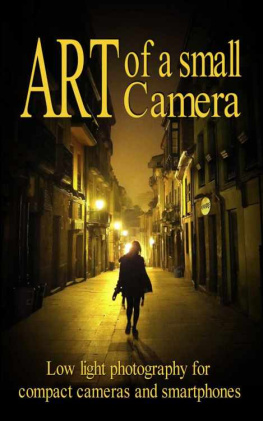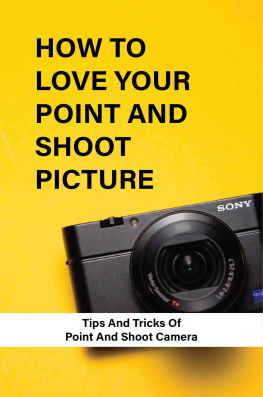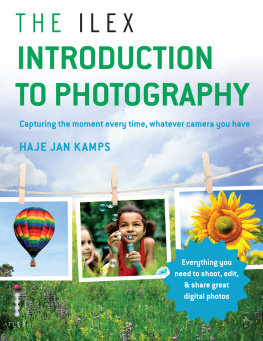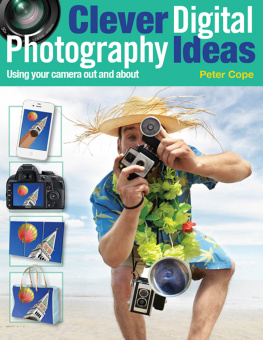Without limiting therights under copyright reserved above, no part of this publication may bereproduced, stored in or introduced into a retrieval system, or transmitted, inany form, or by any means (electronic, mechanical, photocopying or otherwise),without the prior written permission of the copyright owner.
Chapter 1 Introduction
The small camera in your pocket is infinitely better thanthe professional camera you left at home. If you carry a smartphone or compact camerayou are always subconsciously looking for pictures to take even seasonedprofessionals use them.
So if small cameras are so great why do keenphotographers spend thousands on large cameras? There are several reasons, butone of the most important is light sensitivity. Large cameras only need thesmallest amount of light to take a quality picture. If you used a small camerato take a photograph of the same scene, the picture would be blurred and grainywith faded, unnatural colours. Most people assume you need a flash in thesesituations, but flash light tends to be harsh and unflattering; it overpowersthe beautiful natural light all around us, and kills the atmosphere.
You dont need a flash if you have a littleunderstanding of light nor do you need a large camera. Once you understandthe role of light in photography it quickly becomes second nature.
Photography is about art, light and the optics of theeye its not about computers and electronics. Im assuming you have noprevious knowledge of photography and are more interested in art thantechnology. I will explain how a camera works from a technical point of view,but will keep it short and to the point. I will show you one or two simpletechniques that allow you to take creative control of your camera, but onlytake a second more than point-and-shoot.
But photography isnt just about the camera, its aboutcomposition and narrative too. Novice photographers take pictures of people andobjects: the experts paint stories with light.

Theres no point in travelling light with a small camera, if you have to cart around a heavy tripod. The technique I will show you in this book will free you from the bulky tripod, allowing you to create beautiful handheld pictures, with vibrant colours and minimal grain, with very little light.
All the photographs in this book were taken by myself, usinga camera small enough to fit in a regular-sized pocket theres no cheating. When I started writingthis book I set myself a rule: everything has to fit comfortably in onepocket of my jeans. If it doesnt fit in one pocket, it doesnt fit in thisbook.
This technique is particularly well suited for a range of photographic subjects, including cityscapes at night:

Street photography after dark:

Parties and nightclubs:

Demonstrations and protests:

Abstracts:

And even pets and kids:

Ive used many of the pictures twice, to keep the size ofthe e-book down to a manageable size. Each one has been chosen to demonstratemultiple points of technique. Some of the photos in this book are black and white,while others are in colour. If youre reading this on an e-ink device, such asa kindle, the colour images won't convert well. If you want to see the colourimages in all their glory, you will need to download a copy of the book on to acolour device. This is usually free to do depending on where you bought the originalcopy.
Recommended cameras
Small cameras have small sensors, which need a lot of lightto take a quality picture. Any camera that addresses this issue is preferableto one that ignores the problem. The ideal small camera is one that attempts tocram a large sensor into a small body.
.
I own and recommend the following cameras, startingfrom the cheapest:
Canon Ixus 240 HS: A tiny ultra-compact camera.
Canon S110: Excellent balance between size, cost andquality.
Sony RX100: My favourite camera. Its just smallenough to fit in the pocket of my jeans, but the picture quality is comparableto some entry-level DSLRs (very large cameras). Some may find it a little toobig or too expensive it depends on how big your pockets are.
Nokia Lumia 925: This smartphone camera has anincredible optical image stabilisation system, making it perfect for thetechniques used in this book particularly if you're using the Nokia Cameraapp.
Apple iPhone 5: Thesmallest, but also the most expensive camera on the list. It has a surprisinglygood camera, particularly in the sun, but its low-light performance is notparticularly good, as it lacks a full optical image stabilisation system.
If you're not sure about the benefits of smartphones versuscompacts Ive added a few more notes about smartphones .This book is about smartphone and compact cameras, but all the tips and trickswork for entry-level DSLRs too, providing you use the kit lens (the one thatcame with the camera). If you switch to a more specialist lens, some of thetips wont work. I recommend the Nikon 3000 or 5000 series.
Dont worry if you dont own one of these specificcameras the advice is good for all small cameras, smartphones, gadget camerasand entry-level DSLRs (with the kit lens). Its probably best to start with thecamera you have, and then consider upgrading once youve tried some of the tipsand tricks.

The megapixel myth
Most people assume a camera with twelve megapixels will bebetter than a camera with eight megapixels this is not necessarily the case. Crammingtoo many pixels on a small sensor reduces the cameras ability in low light. Youonly need about six to eight megapixels unless you're intending to create largeprints. Small cameras do need low-light ability, but dont need excessiveamounts of pixels. If a camera receives good reviews for its low-light ability,dont be put off by a modest pixel count.

Chapter 2 Getting Started
How does a camera work?
Most peopleassume you have to be good at technology to understand cameras, but photographyis surprisingly simple and intuitive; its the computer and electronics insideyour camera that are hard to understand. Fortunately, you dont need to understandthem to be able to use a camera well. Photography is about light, art and theoptics of the eye its not about electronics and computers. Once youunderstand the four basic principles of the camera, everything else will fallinto place:
















